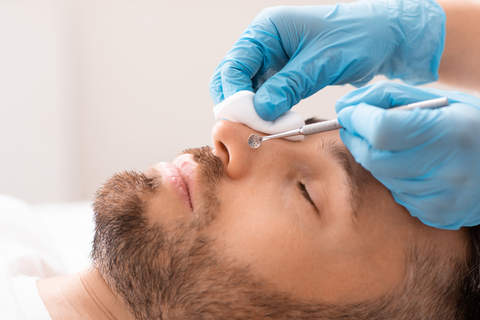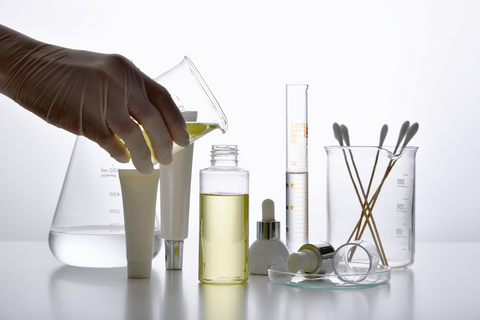PORE CLOGGING INGREDIENTS TO AVOID IF PRONE TO ACNE
Pores, they are a part every human body and essential to our body’s function. We've all got these tiny openings in our skin for releasing gases, sweat and oil, and for some people, they can be more temperamental than others due to genetics, lifestyle and men’s skincare product choices.
What Are Pores?
Pores are tiny openings around hair follicles and sweat glands. They are present anywhere on your skin where there are oil glands, though they are more concentrated on your face, such as the pores on your nose.
The main function of pores is to allow the passage of gases and fluids through the surface to regulate bodily function. Pores are tiny indentations in your skin’s surface which allows the skin to breath, detoxify and pass gases and excrete fluids from the body. Hair follicle pores support the lubrication scalp and hair through the excretion of sebum. When pores clogged, it can cause various skin issues.
What are Clogged Pores?

Clogged pores happens when excess oil, dead skin cells, sweat, and other impurities accumulate inside . There are many reasons you can end up with clogged pores, especially if you have oily skin or are prone to acne. The absence of a good men’s skincare routine with daily cleansing, daily moisturize with a face balm and 2X weekly exfoliation with a men’s face scrub can also be blamed. Clogged pores are more prevalent in men due to our thicker and oilier skin.
Once your pores are clogged, the resulting acne can come in a few different forms. These can range from minor blackheads and whiteheads to more serious blemishes like inflamed papules, pustules, nodules, or cysts.
Comedogenic are Pore Clogging Ingredients?
Comedogenic is the scientific word for pore clogging ingredients. While these types of ingredients aren't the sole cause of acne and breakouts, they certainly can add to the problem. Pore clogging ingredients in men’s skincare products make it much more likely that pimples will form especially in someone with naturally oily skin or someone who harbors the bacteria that causes acne. Using these pore clogging ingredients can increase the occurrences exacerbating acne and causing breakouts.
So what makes an ingredient likely to be pore clogging? Comedogenicity isn't a perfect science, in some cases, ingredients can interact poorly with your sebum, making it thicker, while other ingredients are too thick for sebum to pass through. Pore clogging ingredients are typically occlusive, these sit on top of the skin, forming a seal that ends up trapping oil, particularly when someone has oily skin to start. Some pore clogging ingredients add more oils to the skin, causing cells to stick together and adhere more tightly instead of sloughing off as they typically do from the lining of the pore.
Comedogenic Scale
The comedogenic scale ranges from 0 to 5, with 0 being non-comedogenic (least likely to clog pores) and 5 being highly comedogenic (most likely to clog pores). Understanding this scale give you a general guideline to make more informed decisions when choosing your men's skincare products.
Pore Clogging Ingredients to Avoid

Now that you understand why comedogenic ingredients can increase your breakouts, it's time to learn which ones specifically to consider avoiding. Comedogenicity, again is not a perfect science and not the only determinant of whether an ingredient should be excluded all together. A key part is dependent on how much of the ingredient is in the formulation (you can usually tell by how high up it is on the ingredient list) and what other ingredients it is formulated with. It also has nothing to do with whether the ingredient is natural, “clean” or lab created. There are a lot of “natural and clean” ingredients that can clog pores.
We’ve put together a short list of pore clogging ingredients that might be worth steering clear of if you’re a man prone to acne.
Petroleum Jelly
Commonly known as Vaseline and often seen in viral TikTok slugging trend, petroleum jelly is one ingredient you'll definitely want to skip if you're always battling breakouts. It's very thick, sitting on the surface of the skin and can suffocated the pores, leading to oil and dead cell buildup that can ultimately turn into a pimple.
Cocoa Butter
Although coco butter has beneficial properties to moisturize the skin but it is also high in oleic acid, a fatty acid, which tends to be more comedogenic and puts it at a high rating of 4 on the comedogenic scale. An alternative that's just as moisturizing but won't clog pores is shea butter, which is non-comedogenic.
Coconut Oil
Rated 4 on the comedogenic scale and is another popular ingredient in many skincare and hair care products. It’s a natural antioxidant as well as anti-fungal. While coconut oil can be pore clogging, you would have to see where it is on the ingredient list. If it is lower on the list, it may not affect your skin. However, if you are prone to acne then it might be best to skip it.
Silicone
Even though silicones are a 1 on the comedogenic scale they can still potentially cause pimples in some, especially if you are prone to acne. If you suspect silicones area breaking you out, forms of silicone and its derivatives include dimethicone, methicone, trimethicone, cyclopentasiloxane, and cyclotetrasiloxane.
Lanolin
Lanonin has a rating of 4 on the comedogenic scale making them highly comedogenic. It is derived from sheep and is common ingredient in men’s skincare products like moisturizers. We believe this to be a beneficial moisturizing ingredient when use at the right level. Lanolin closely resembles the natural oils made by our own skin to create the skin barrier. Lanolin can hold multiple times its own weight in moisture, this helps skin to recover from moisture loss. Lanolin has the ability to penetrate deeply into multiple skin layers. Bringing moisture deep into the lower skin layers.
Lanolin comes in many versions. The two most likely versions to consistently clog pores regardless of your skin type: acetylated lanolin and acetylated lanolin alcohol.
Marula Oil
Coming in at 3-4 on the comedogenic scale, theoretically not suitable for those prone to acne. We believe marula oil to be a nourishing and beneficial ingredient for most people when used at the right level. But if you’re very much prone to acne then consider swapping it out for squalane or grape seed oil instead. Both oils behave similarly to your skin's natural oils and are not pore clogging.
Pore Clogging Ingredients Checker
A quick google search will reveal that there are a plethora of skincare companies and clinics with their own pore clogging ingredients list. They also have online apps to rank where the specific ingredient falls on the comedogenic scale to help you make more informed decisions on your men’s skincare choices. A word of caution is to use these tools as a general guideline and make your final decision based on the product's over all formulation.
If you're dealing with scalp acne as well then take a read thru PORE CLOGGING INGREDIENTS TO AVOID FOR SCALP ACNE to gain some insight on ingredients to avoid in your haircare products.
Why Choose urth?
urth has curated skin care kits for men to simplify men's skincare routine. These plant powered men’s skin care products are formulated with non pore clogging ingredients like chamomile, green tea, ginseng and pure essential oils to cleanse, brighten and nourish skin for a healthy and clear complexion. Improved and better skin after every use. Perfect for all skin types - including men with sensitive, dry, combo, and oily skin.

